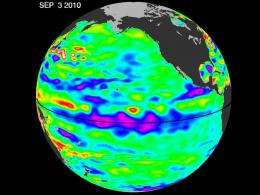Pacific chills with growing La Nina

(糖心视频Org.com) -- The tropical Pacific Ocean has transitioned from last winter's El Nino conditions to a cool La Nina, as shown by new data about sea surface heights, collected by the U.S-French Ocean Surface Topography Mission (OSTM)/Jason-2 oceanography satellite.
This OSTM/Jason-2 image of the Pacific Ocean is based on the average of 10 days of data centered on Sept. 3, 2010. A new image depicts places where the Pacific sea surface height is higher (warmer) than normal as yellow and red, with places where the sea surface is lower (cooler) than normal as blue and purple. Green indicates near-normal conditions. Sea surface height is an indicator of how much of the sun's heat is stored in the upper ocean.
La Ni帽a ocean conditions often follow an El Ni帽o episode and are essentially the opposite of El Ni帽o conditions. During a La Ni帽a episode, trade winds are stronger than normal, and the cold water that normally exists along the coast of South America extends to the central equatorial Pacific. La Ni帽a episodes change global weather patterns and are associated with less moisture in the air over cooler ocean waters, resulting in less rain along the coasts of North and South America and the equator, and more rain in the far Western Pacific.
"This La Ni帽a has strengthened for the past four months, is strong now and is still building," said Climatologist Bill Patzert of NASA's Jet Propulsion Laboratory, Pasadena, Calif. "It will surely impact this coming winter's weather and climate.
"After more than a decade of mostly dry years on the Colorado River watershed and in the American Southwest, and only one normal rain year in the past five years in Southern California, water supplies are dangerously low," Patzert added. "This La Ni帽a could deepen the drought in the already parched Southwest and could also worsen conditions that have fueled Southern California's recent deadly wildfires."
NASA will continue to track this change in Pacific climate.
The comings and goings of El Ni帽o and La Ni帽a are part of a long-term, evolving state of global climate, for which measurements of sea surface height are a key indicator. JPL manages the U.S. portion of the OSTM/Jason-2 mission for NASA's Science Mission Directorate, Washington, D.C.
More information: To view the latest Jason-1 and OSTM/Jason-2 data, see
Provided by JPL/NASA


















